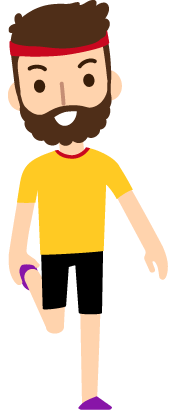Running takes an undoubtable toll on your body. Yoga techniques for runners can help relieve a great deal of the stress that builds up during a run. Taking time to stretch, rest, and refuel after a run can make a huge difference in your recovery.
There are times when standing yoga stretches after a run are sufficient.
And there are times when using your vehicle or wall for post-run yoga is just the thing you need.
Then, there are times when we end a run, and we must sit now.
Typically, for me, and lots of runners I know, that feeling happens on a few occasions:
This story covers the post-run seated and supine postures I do on these occasions.
First, let's review a few things...
“I’m not flexible enough for yoga.”
“I thought yoga/stretching wasn’t good for runners.”
Furthermore, yoga is a dynamic, heat-building practice that encompasses:
In other words, yoga is not simply sitting on your butt, passively stretching or pulling yourself into contorted, painful shapes.
Do you see the common denominator in all of these statements?
Right now, take a deep breath through your nose with your mouth closed if possible.
Do it again. Keep breathing deeply in, filling up the belly, ribs, back and chest, as long as you can, and then breathe deeply out.
There, you are doing yoga. One might even say you are meditating.
So let’s get to it. Where were we?
We just finished running.
Let’s transition to the next thing in life slowly, with post-run yoga.
Do not:
Let’s get off our feet and begin the recovery process ASAP. When it’s cold outside, I quickly change clothes and shut myself into my vehicle to perform this sequence.
Benefits:
Benefits:
Benefits:
Benefits:
Benefits:
Benefits:
Benefits:
Benefits:
Benefits:
Benefits:
Benefits:
If 11 poses seems like too many, start with one pose and hold it for three breaths per side.
The next day, choose another pose.
The purpose is to decompress and settle into the breath in order to elevate your recovery experience, which is as equally important as your training session.
Questions about poses? Please post in the comments.
Happy running and happy yoga!
Favorite Yoga App for Daily Morning Practice:
What Brynn’s Wearing:
Brynn Cunningham received her 230-hour yoga instructor certification from the Asheville Yoga Center (AYC) in North Carolina in 2015.
Past and present yoga clients and teaching locations include:
Photography by Colleen O’Neil

John Jeren Wow. Great article. Really informative. Flexibility is something I've always struggled with as a runner. Thanks.
Brynn Cunningham Thanks, John. Hope it helps you run forever :)
Login to your account to leave a comment.





We Want to Give it to You!
